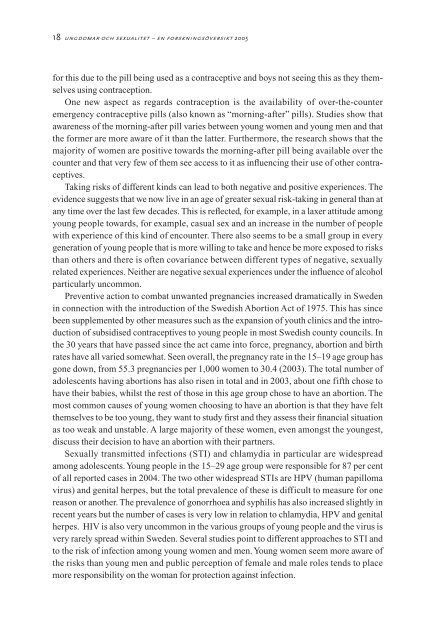Ungdomar och sexualitet - Statens folkhälsoinstitut
Ungdomar och sexualitet - Statens folkhälsoinstitut
Ungdomar och sexualitet - Statens folkhälsoinstitut
You also want an ePaper? Increase the reach of your titles
YUMPU automatically turns print PDFs into web optimized ePapers that Google loves.
18 ungdomar <strong>och</strong> <strong>sexualitet</strong> – en forskningsöversikt 2005<br />
for this due to the pill being used as a contraceptive and boys not seeing this as they themselves<br />
using contraception.<br />
One new aspect as regards contraception is the availability of over-the-counter<br />
emergency contraceptive pills (also known as “morning-after” pills). Studies show that<br />
awareness of the morning-after pill varies between young women and young men and that<br />
the former are more aware of it than the latter. Furthermore, the research shows that the<br />
majority of women are positive towards the morning-after pill being available over the<br />
counter and that very few of them see access to it as influencing their use of other contraceptives.<br />
Taking risks of different kinds can lead to both negative and positive experiences. The<br />
evidence suggests that we now live in an age of greater sexual risk-taking in general than at<br />
any time over the last few decades. This is reflected, for example, in a laxer attitude among<br />
young people towards, for example, casual sex and an increase in the number of people<br />
with experience of this kind of encounter. There also seems to be a small group in every<br />
generation of young people that is more willing to take and hence be more exposed to risks<br />
than others and there is often covariance between different types of negative, sexually<br />
related experiences. Neither are negative sexual experiences under the influence of alcohol<br />
particularly uncommon.<br />
Preventive action to combat unwanted pregnancies increased dramatically in Sweden<br />
in connection with the introduction of the Swedish Abortion Act of 1975. This has since<br />
been supplemented by other measures such as the expansion of youth clinics and the introduction<br />
of subsidised contraceptives to young people in most Swedish county councils. In<br />
the 30 years that have passed since the act came into force, pregnancy, abortion and birth<br />
rates have all varied somewhat. Seen overall, the pregnancy rate in the 15–19 age group has<br />
gone down, from 55.3 pregnancies per 1,000 women to 30.4 (2003). The total number of<br />
adolescents having abortions has also risen in total and in 2003, about one fifth chose to<br />
have their babies, whilst the rest of those in this age group chose to have an abortion. The<br />
most common causes of young women choosing to have an abortion is that they have felt<br />
themselves to be too young, they want to study first and they assess their financial situation<br />
as too weak and unstable. A large majority of these women, even amongst the youngest,<br />
discuss their decision to have an abortion with their partners.<br />
Sexually transmitted infections (STI) and chlamydia in particular are widespread<br />
among adolescents. Young people in the 15–29 age group were responsible for 87 per cent<br />
of all reported cases in 2004. The two other widespread STIs are HPV (human papilloma<br />
virus) and genital herpes, but the total prevalence of these is difficult to measure for one<br />
reason or another. The prevalence of gonorrhoea and syphilis has also increased slightly in<br />
recent years but the number of cases is very low in relation to chlamydia, HPV and genital<br />
herpes. HIV is also very uncommon in the various groups of young people and the virus is<br />
very rarely spread within Sweden. Several studies point to different approaches to STI and<br />
to the risk of infection among young women and men. Young women seem more aware of<br />
the risks than young men and public perception of female and male roles tends to place<br />
more responsibility on the woman for protection against infection.



